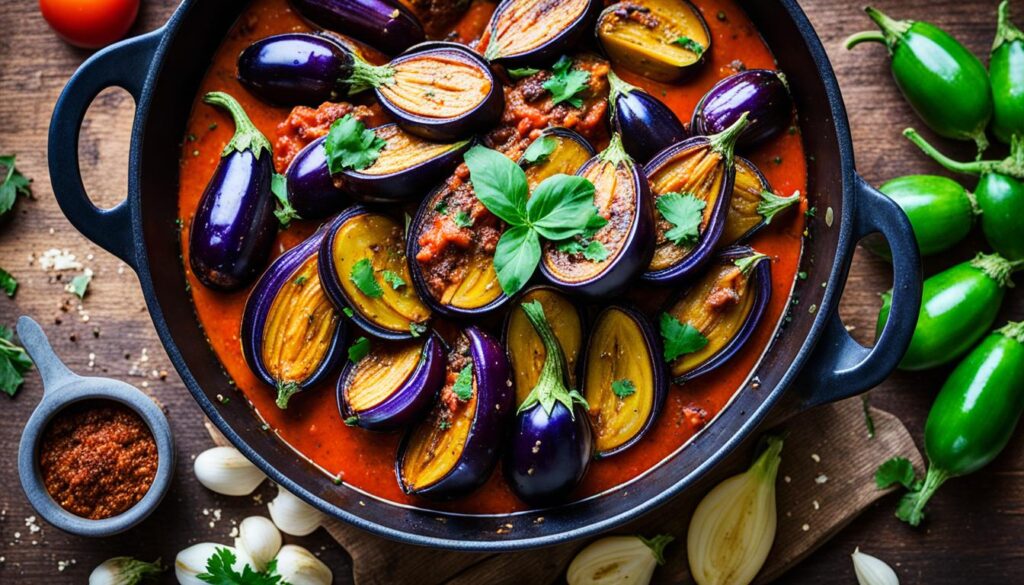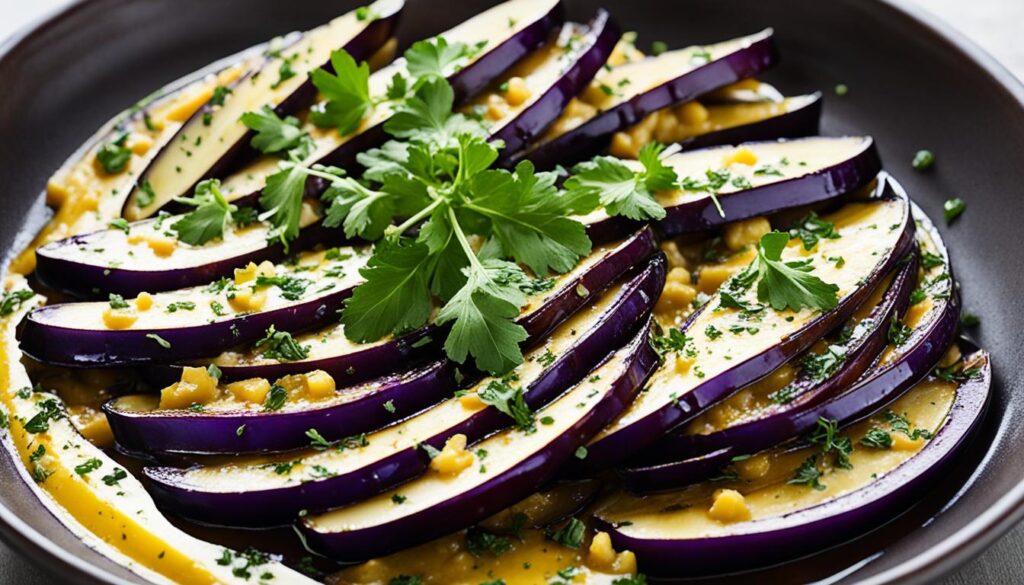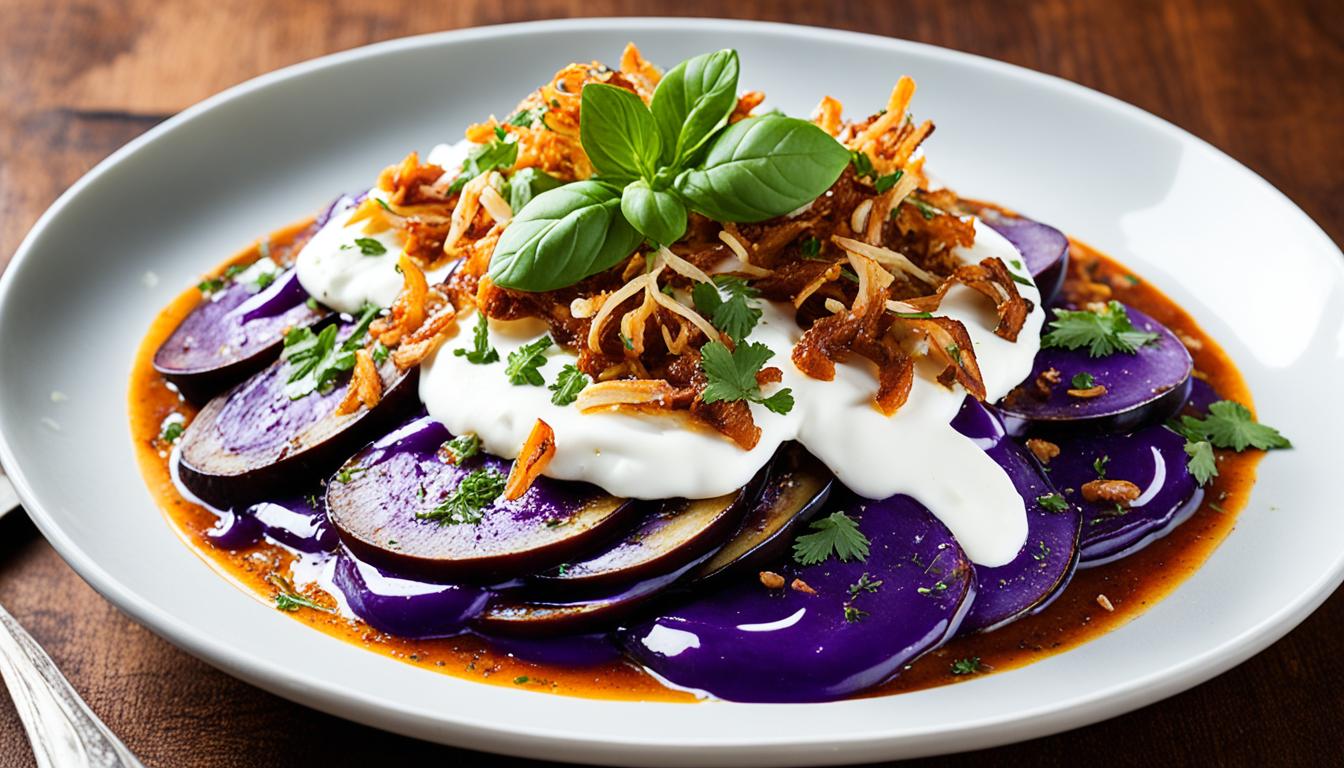Are you ready to embark on a culinary adventure through the rich and vibrant flavors of Persian cuisine? Look no further than the enticing dish of Persian Braised Eggplant with Kashk. With its creamy texture and caramelized flavor, this traditional Iranian eggplant dish is sure to captivate your taste buds.
But what exactly is kashk, and how does it enhance the flavors of this dish? How did eggplant become a staple in Persian cooking? Join us as we explore the history, preparation, and variations of this mouthwatering delicacy.
Key Takeaways:
- Discover the magic of kashk and its role in Persian cuisine
- Uncover the history of the beloved Persian dish, Kashk-o-bādemjān
- Learn how to prepare this flavorful eggplant dish
- Explore the different varieties of eggplants used in Persian cooking
- Unlock the variations of Kashk-e Bademjan and get creative in the kitchen
The History of Kashk and Eggplant in Persian Cuisine
In Persian cuisine, the combination of kashk and eggplant has a rich history that spans centuries. Kashk, a fermented dairy product, has been a staple in Iranian culinary traditions for thousands of years. Made from the leftover liquid of strained yogurt, kashk adds a tangy and savory flavor to many dishes.
Eggplant, on the other hand, was introduced to the Iranian plateau around the 8th century CE. It quickly became a beloved ingredient in Persian cooking, known for its versatility and ability to absorb flavors.
One iconic dish that brings together the flavors of kashk and eggplant is kashk-o-bādemjān. This appetizer, with references dating back to the 14th century, has become a cherished part of Persian cuisine. The creamy texture of kashk beautifully complements the caramelized flavor of braised eggplant, resulting in a delightful dish that is enjoyed by both locals and visitors alike.
To truly understand the depth of flavors in Persian cuisine, one must explore the historical roots of ingredients like kashk and eggplant. These timeless flavors continue to captivate the taste buds of those who appreciate the richness and complexity of Persian dishes.
| Kashk | Eggplant |
|---|---|
| Essential element in Iranian cuisine | Introduced in the 8th century CE |
| Fermented dairy product | Versatile and flavorful |
| Tangy and savory flavor | Ability to absorb flavors |
| References dating back to the 14th century | Popular ingredient in Persian cuisine |
The Role of Kashk in Persian Cooking
Kashk plays a vital role in Persian cuisine and is an essential ingredient in many traditional Persian dishes. Known for its tangy and sourish flavor, kashk adds a unique and popular taste to various recipes. It possesses umami characteristics that are reminiscent of mature Parmesan cheese, making it a versatile and flavorful ingredient.
Kashk can be obtained in different forms, including dried powder, dried chunks, or as a concentrated liquid. This variety allows for its versatile use in Persian cooking, enabling cooks to experiment with different textures and flavors. Whether it’s sprinkling dried kashk on top of dishes or incorporating the concentrated liquid form into soups and porridge-like preparations, kashk adds an unmistakable Persian touch.
“Kashk is a key ingredient in Persian cuisine, lending its tangy and savory notes to a range of dishes.”
Kashk is prominently featured in classic Persian recipes such as kashk-o-bādemjān, the famous Iranian eggplant dish. Its distinctive flavor profile perfectly complements the rich and silky texture of braised eggplant, creating a harmonious blend of flavors. Kashk’s inclusion not only enhances the taste but also elevates the overall dining experience, making it a beloved dish among Persian food enthusiasts.
Aside from kashk-o-bādemjān, the uses of kashk extend to other culinary creations within Persian cuisine. This versatile ingredient finds its way into thick soups and stews, intensifying their flavors and adding a delightful tang. Its presence can transform ordinary dishes into extraordinary culinary masterpieces, showcasing the richness and diversity of Persian cooking.
Different Forms of Kashk
| Kashk Form | Description |
|---|---|
| Dried Powder | A powdered form of kashk that can easily be sprinkled on dishes for an added tangy flavor. |
| Dried Chunks | Kashk is molded into solid chunks, which can be crumbled or grated to incorporate in various recipes. |
| Concentrated Liquid | A thick and potent form of kashk that can be blended into soups and stews for a rich and tangy taste. |
Exploring the different forms of kashk allows chefs to unleash their creativity in the kitchen and experiment with authentic Persian flavors. Whether it’s adding a sprinkling of dried kashk or incorporating the concentrated liquid, the distinct taste of kashk enhances the authenticity and depth of Persian dishes, creating a memorable culinary experience.
The Different Varieties of Eggplant Used in Persian Cooking
Persian cuisine embraces the unique flavors and versatility of eggplant, a staple in many traditional dishes. When it comes to creating popular eggplant-based recipes like kashk-o-bādemjān, Persian chefs rely on two main varieties of this delectable vegetable: the skinny purple eggplant and the fat purple eggplant.
The choice of eggplant variety depends on the specific dish being prepared. For dishes like eggplant stew or eggplant main dishes, the skinny purple eggplants are preferred. These eggplants are easier to pan-fry, allowing them to develop a beautiful golden brown color. Additionally, their slender shape helps them hold their form during the braising process, resulting in a more visually appealing presentation and an enhanced mouthfeel.
However, for popular Persian dishes such as kashk-o-bādemjān, any variety of eggplant can be used as long as it is not seedy. The key consideration is to select eggplants with minimal or no noticeable seeds, as this creates a smoother and more enjoyable texture in the final dish. With their firm flesh and relatively fewer seeds, the skinny eggplants are often the preferred choice for kashk-o-bādemjān, allowing the flavors to shine through without any undesirable bitterness.
To get a better understanding of the differences between the two varieties, here is a comparison table:
| Eggplant Variety | Characteristics |
|---|---|
| Skinny Purple Eggplant | – Easier to pan-fry – Retains shape during braising – Minimal seeds |
| Fat Purple Eggplant | – Larger size – More seeds – Softer flesh |
Regardless of the variety chosen, both skinny and fat purple eggplants add a delightful earthy flavor and velvety texture to Persian cuisine. Their versatility enables them to be used in a wide range of dishes, making them an essential ingredient in Persian recipes. So, whether you’re preparing a flavorful eggplant stew or a savory eggplant main dish, experimenting with these eggplant varieties will elevate your Persian culinary experiences.

How to Prepare Kashk-o-bādemjān
To prepare kashk-o-bādemjān, start by pan-frying the eggplants until they turn golden brown. This step adds a delicious caramelized flavor to the dish. Once pan-fried, set the eggplants aside.
In the same pan, sauté onions and garlic until they become soft and fragrant. This adds a savory depth of flavor to the kashk-o-bādemjān.
Pro Tip: For added richness, you can use butter or olive oil to sauté the onions and garlic.
Next, return the pan-fried eggplants to the pan and mix them well with the onions and garlic.
In a separate bowl, combine kashk, saffron, and dried mint. The mix of these ingredients adds a unique tanginess and aromatic quality to the dish.
Add the kashk mixture to the pan and continue cooking until the flavors are well incorporated. This step allows the dish to develop its rich and creamy taste.
Once cooked, serve the kashk-o-bādemjān warm with bread such as lavash or pita. The combination of the silky eggplants and tangy kashk is sure to delight your taste buds with every bite.

Table of Contents:
- Brief for Section 1
- Brief for Section 2
- Brief for Section 3
- Brief for Section 4
- How to Prepare Kashk-o-bādemjān
- Brief for Section 6
- Brief for Section 7
Variations of Kashk-e Bademjan
When it comes to preparing Kashk-e Bademjan, there are various ways to make this delectable Persian dish. While the most essential recipe includes eggplants, onion, garlic, and kashk, there are several techniques and additions that can enhance its flavors and textures.
The traditional method: Primarily, the traditional approach involves frying the eggplants, onion, and garlic separately, then mashing them together with kashk. This method ensures that each ingredient is cooked to perfection, resulting in a harmonious blend of flavors in the final dish.
Minimizing oil usage: For those who prefer a lighter version, the eggplants can be either baked or fried with the onions and garlic in the same pan. This technique reduces the amount of oil needed without compromising the signature taste and texture of Kashk-e Bademjan.
Enhancements and toppings: Experimenting with different toppings can take your Kashk-e Bademjan to new heights of flavor. Try adding chopped walnuts for a delightful crunch or caramelized onions for an extra touch of sweetness. These additions bring new dimensions to the dish, making it even more enticing and satisfying.
“Kashk-e Bademjan is a versatile dish that invites creativity and personalization. By exploring various cooking methods and experimenting with toppings, you can add your own unique twist to this classic Persian recipe.”
Whether you choose to stick with the traditional method or explore different variations, the result will always be a delicious and satisfying eggplant stew that showcases the rich flavors of Persian cuisine.
Variations of Kashk-e Bademjan
| Variation | Method |
|---|---|
| Traditional | Fry eggplants, onion, and garlic separately, then mash together with kashk |
| Minimizing Oil | Bake or fry eggplants with onions and garlic in the same pan to reduce oil usage |
| Enhancements | Add toppings such as chopped walnuts or caramelized onions for added flavor and texture |
Conclusion
Persian braised eggplant with kashk, or kashk-o-bādemjān, is a beloved dish in Persian cuisine that showcases the rich flavors and textures of traditional Persian food. The combination of silky braised eggplant and tangy kashk creates a delightful flavor profile that is both savory and creamy. Whether served as an appetizer or a main dish, kashk-o-bādemjān is sure to captivate the taste buds of anyone who tries it.
With its origins dating back centuries, this iconic Iranian eggplant dish has stood the test of time, becoming a staple in Persian recipes and a favorite among food enthusiasts around the world. The process of pan-frying the eggplant until it achieves a deep golden brown color, followed by braising it in a small amount of water, transforms it into a lusciously tender and flavorful addition to any meal.
By infusing the kashk, a fermented dairy product with a tangy and savory taste, into every bite of the braised eggplant, kashk-o-bādemjān elevates the dish to new heights. The umami character of the kashk complements the caramelized flavors of the eggplant, resulting in a truly unforgettable culinary experience.
Whether you’re seeking a taste of traditional Persian food or looking to expand your repertoire of Persian recipes, kashk-o-bādemjān is a dish that embodies the essence of Iranian cuisine. Its creamy textures, vibrant flavors, and aromatic spices make it a standout choice for anyone craving a memorable and satisfying meal.
